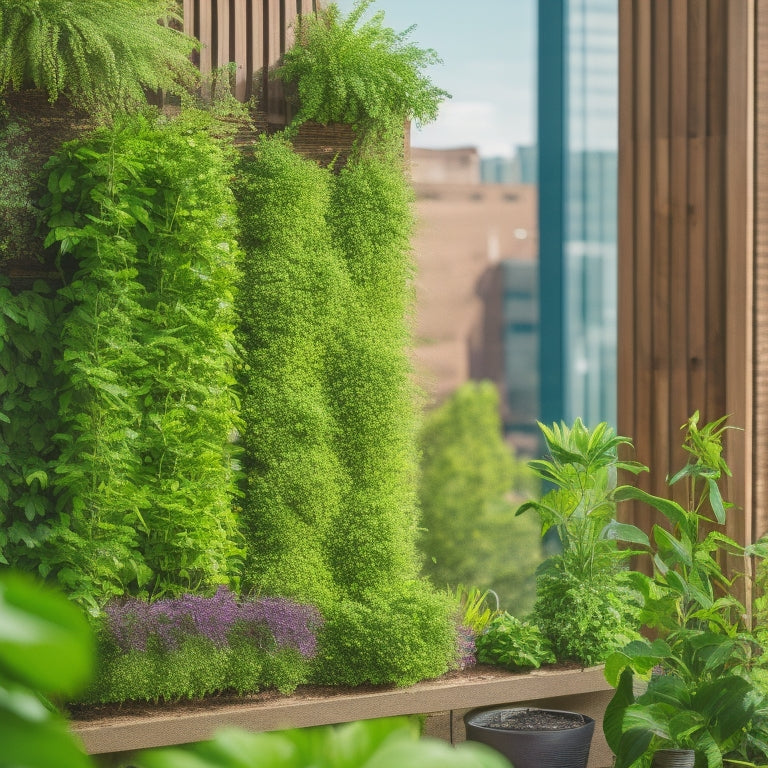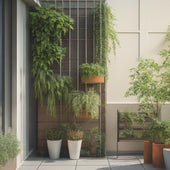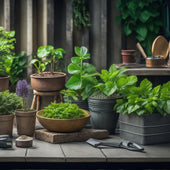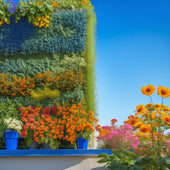
7 Essential Tips for Weed-Free DIY Vertical Gardens
Share
To create a stunning, low-maintenance DIY vertical garden, you'll want to start by choosing compact plants with small roots, preparing your wall properly, and using a weed-blocking membrane. Select a good growing medium with a balanced pH and aeration, and water wisely with efficient irrigation methods. Mulching can also help prevent weeds, and regular inspections will guarantee you catch any potential issues early. By following these essential tips, you'll be well on your way to a thriving, weed-free oasis. Now, discover the specific strategies and techniques to bring your vision to life.
Key Takeaways
• Choose compact plants with small roots, like succulents and herbs, that thrive in vertical environments and have compatible growing conditions.
• Prepare the wall by verifying its sturdiness, inspecting for cracks, and cleaning it thoroughly to establish a solid foundation for the garden.
• Use a weed-blocking membrane with the right pore size to prevent weed growth, and consider mulching with organic or synthetic materials.
• Select a growing medium with a pH between 6.0 and 7.0, good aeration, and water retention capabilities to support healthy root growth.
• Regularly inspect the garden to identify and remove weeds, monitor for nutrient deficiencies, and adjust watering schedules to maintain optimal conditions.
Choose the Right Plants First
To guarantee the success of your DIY vertical garden, start by selecting plants that thrive in vertical environments and can tolerate the conditions you can provide.
You'll want plants that are compact, produce small roots, and don't require a lot of pruning. Consider plants like succulents, herbs, and flowering plants like petunias or begonias.
When choosing plants, think about plant compatibility - select plants that have similar growing conditions and light requirements. This will verify that your plants coexist peacefully and reduce competition for resources.
Proper plant spacing is also essential. Overcrowding can lead to disease and pest issues, so make sure to leave enough space between each plant for air to circulate and for their roots to grow.
A general rule of thumb is to space plants 6-12 inches apart, depending on their mature size.
Prepare the Wall Properly
Before mounting your DIY vertical garden, verify the wall is sturdy enough to support the weight of the plants, frame, and growing medium by checking for any cracks, holes, or water damage that could compromise its structural integrity.
You don't want your beautiful garden to come crashing down due to a weak wall. Inspect the wall materials, confirming they're suitable for the weight and moisture levels your garden will introduce. For instance, if you have a brick or concrete wall, it's crucial to check for any cracks or weaknesses that could allow water to seep behind the wall and cause damage.
Consider the wall orientation as well. A south-facing wall receives direct sunlight, which can be beneficial for plants, but it may also lead to increased heat and moisture levels. Confirm your wall can withstand these conditions.
Clean the wall thoroughly to remove any dirt, grime, or old adhesives that could interfere with your garden's installation. By taking the time to prepare your wall properly, you'll create a solid foundation for your DIY vertical garden to thrive.
Use a Weed-Blocking Membrane
When creating a weed-free DIY vertical garden, you'll want to select a weed-blocking membrane that's specifically designed for this purpose.
You'll need to take into account factors such as the membrane's material, thickness, and permeability to guarantee it effectively blocks weed growth while allowing water and air to reach your plants.
Membrane Selection Criteria
You'll need to choose a membrane that effectively blocks weeds from growing up through your vertical garden, while also allowing water and air to reach your plants. This vital step guarantees your DIY project remains weed-free and thriving.
When selecting a membrane, consider the following criteria:
-
Material durability: Opt for membranes made from high-quality, UV-stable materials that can withstand outdoor conditions.
-
Pore size and density: Choose a membrane with a pore size that allows for adequate water and air flow while preventing weed growth.
-
Ease of installation: Select a membrane that's easy to install, using techniques such as stapling, gluing, or clipping, to guarantee a secure fit.
Blocking Weed Growth
With your membrane selected, it's time to put it to use and effectively block weeds from growing up through your vertical garden. By installing a weed-blocking membrane, you're taking an important step in maintaining a weed-free DIY vertical garden. This weed control method is essential in garden design, as it prevents weeds from competing with your plants for water, nutrients, and light.
Here's a breakdown of the benefits of using a weed-blocking membrane:
| Benefit | Description | Impact |
|---|---|---|
| Reduced Weed Growth | Prevents weeds from growing up through the membrane | Saves time and effort in weeding |
| Improved Soil Health | Reduces soil disturbance, preserving soil structure and microorganisms | Promotes healthy plant growth |
| Increased Water Efficiency | Prevents weeds from absorbing water meant for your plants | Conserves water and reduces waste |
| Enhanced Aesthetics | Creates a clean, weed-free appearance | Boosts visual appeal and pride of ownership |
| Simplified Maintenance | Reduces the need for frequent weeding and pruning | Saves time and energy for more enjoyable activities |
Select a Good Growing Medium
Choosing the right growing medium is essential, as it provides the foundation for healthy plant growth in your DIY vertical garden. You want a medium that will support your plants' roots, retain moisture, and allow for proper drainage. A good growing medium should also have a well-balanced soil composition, with a mix of organic matter, perlite, and vermiculite.
When selecting a growing medium, consider the following factors:
-
pH level: Make certain the medium has a pH level between 6.0 and 7.0, which is suitable for most plants.
-
Water retention: Look for a medium that can hold water but also drain excess moisture to prevent waterlogged soil.
-
Aeration: Choose a medium with good aeration to guarantee healthy root growth and prevent root rot.
Water Wisely and Efficiently
Proper watering techniques are essential in DIY vertical gardens, as they directly impact plant health and the overall efficiency of your system. You want to guarantee that your plants receive the right amount of water, without overwatering or underwatering. Drip irrigation is an excellent option for vertical gardens, as it delivers water directly to the roots, reducing evaporation and runoff.
| Watering Method | Advantages | Disadvantages |
|---|---|---|
| Drip Irrigation | Reduces evaporation, precise water delivery | Requires initial setup, can be prone to clogging |
| Sprinkler System | Easy to set up, covers large areas | Leads to evaporation, may not reach all plants |
| Hand Watering | Allows for precision, cost-effective | Time-consuming, may lead to overwatering |
When watering, consider the type of plants you have, the climate, and the soil's moisture retention capabilities. You can check the soil moisture by inserting your finger into the growing medium up to the knuckle. If the soil feels dry, it's time to water. By adopting efficient watering techniques, you'll create a thriving vertical garden that requires minimal maintenance.
Mulch to Prevent Weeds
When it comes to preventing weeds in your DIY vertical garden, you'll want to choose the right mulch for the job.
You're not just looking for any old mulch, but one that'll prevent weed seeds from germinating and taking over.
Mulch Types Matter
By selecting the right mulch for your DIY vertical garden, you'll create a barrier that prevents weeds from growing and competing with your plants for water and nutrients. The type of mulch you choose plays a significant role in maintaining a weed-free garden. You have two primary options: organic mulch and synthetic mulch.
Organic Mulch: Made from natural materials like bark chips, straw, or coconut coir, organic mulch breaks down over time, adding nutrients to the soil. It's an excellent choice for vertical gardens, as it improves soil health and structure.
Synthetic Mulch: Made from materials like plastic or landscape fabric, synthetic mulch is durable and long-lasting. It's ideal for areas with high foot traffic or where you want to maintain a clean, uniform appearance.
Blended Mulch: A combination of organic and synthetic materials, blended mulch offers the benefits of both. It's a great option if you want to create a balanced and effective weed barrier.
Prevent Weed Seeds
Stopping weed seeds from germinating is essential to maintaining a weed-free DIY vertical garden, and the right mulch can be a powerful tool in this fight.
You'll want to choose a mulch that not only suppresses weed growth but also prevents weed seeds from sprouting in the first place. Common weed seed sources include contaminated potting soil, airborne seeds, and seeds that have been dormant in the soil.
To combat these sources, you'll need a mulch that acts as a natural deterrent. Organic mulches like wood chips, bark, or straw can be effective barriers against weed seeds.
These mulches block light, preventing seeds from germinating, and can also alter the soil's temperature and moisture levels, making it less hospitable to weed growth. Additionally, some mulches, like cocoa hulls, have natural compounds that inhibit weed seed germination.
Regularly Inspect and Maintain
Regularly inspecting your DIY vertical garden guarantees that it remains healthy, thriving, and weed-free. Take a few minutes each week to scan your garden from top to bottom. This habit will help you catch any potential issues before they escalate, including weeds that might be trying to take over.
During your inspection, keep an eye out for:
-
Early signs of weed growth, such as tiny leaves or stems, and remove them immediately. Proper weed identification is essential, as some weeds can be mistaken for desired plants.
-
Any signs of nutrient deficiency or pest infestation, and adjust your maintenance schedule accordingly.
-
Areas where soil or growing medium may be drying out, and water or mist as needed.
Frequently Asked Questions
Can I Use a Trellis Instead of a Wall for My Vertical Garden?
You can definitely use a trellis for your vertical garden, opting for sturdy trellis materials like wood or metal. This flexible garden design approach allows you to create a unique, space-saving arrangement that's perfect for small areas.
How Often Should I Fertilize My Vertical Garden Plants?
You'll want to fertilize your vertical garden plants every 1-2 weeks, depending on the type of fertilizer used. Balanced, water-soluble fertilizers provide essential nutrients, while slow-release formulas offer sustained feeding; timing is vital for ideal plant growth.
Will a Vertical Garden Attract Pests Like Mosquitoes or Rodents?
Will you unwittingly invite unwanted guests to your outdoor oasis? Probably not, if you prioritize pest management and regular garden maintenance, as vertical gardens' controlled environments and good air circulation naturally deter mosquitoes and rodents.
Can I Grow Vegetables in a DIY Vertical Garden?
You can grow a variety of vegetables in your DIY vertical garden by selecting compact or vining varieties and employing adapted growing techniques, such as trellising and pruning, to maximize space and yields.
Are Vertical Gardens Suitable for Indoor or Low-Light Spaces?
"Think you can't grow anything except dust bunnies in that dimly lit basement? Think again! You can thrive in indoor spaces with the right indoor plant selection, opting for low light varieties that'll make your DIY vertical garden shine."
Related Posts
-

3 Best Space-Saving Gardening Ideas for Urban Renters
You can turn even the smallest urban space into a lush oasis by utilizing clever space-saving gardening ideas. Maximi...
-

3 Best Space-Saving Gardening Ideas for Urban Renters
You can turn even the smallest urban space into a lush oasis by utilizing clever space-saving gardening ideas. Maximi...
-

3 Best Space-Saving Gardening Ideas for Urban Renters
You can turn even the smallest urban space into a lush oasis by utilizing clever space-saving gardening ideas. Maximi...
-

3 Best Space-Saving Gardening Ideas for Urban Renters
You can turn even the smallest urban space into a lush oasis by utilizing clever space-saving gardening ideas. Maximi...
-

3 Best Space-Saving Gardening Ideas for Urban Renters
You can turn even the smallest urban space into a lush oasis by utilizing clever space-saving gardening ideas. Maximi...
-

3 Best Space-Saving Gardening Ideas for Urban Renters
You can turn even the smallest urban space into a lush oasis by utilizing clever space-saving gardening ideas. Maximi...
-

3 Best Space-Saving Gardening Ideas for Urban Renters
You can turn even the smallest urban space into a lush oasis by utilizing clever space-saving gardening ideas. Maximi...
-

3 Best Space-Saving Gardening Ideas for Urban Renters
You can turn even the smallest urban space into a lush oasis by utilizing clever space-saving gardening ideas. Maximi...
-

3 Best Space-Saving Gardening Ideas for Urban Renters
You can turn even the smallest urban space into a lush oasis by utilizing clever space-saving gardening ideas. Maximi...
-

3 Best Space-Saving Gardening Ideas for Urban Renters
You can turn even the smallest urban space into a lush oasis by utilizing clever space-saving gardening ideas. Maximi...
-

3 Best Space-Saving Gardening Ideas for Urban Renters
You can turn even the smallest urban space into a lush oasis by utilizing clever space-saving gardening ideas. Maximi...
-

3 Best Space-Saving Gardening Ideas for Urban Renters
You can turn even the smallest urban space into a lush oasis by utilizing clever space-saving gardening ideas. Maximi...
-

3 Best Space-Saving Gardening Ideas for Urban Renters
You can turn even the smallest urban space into a lush oasis by utilizing clever space-saving gardening ideas. Maximi...
-

3 Best Space-Saving Gardening Ideas for Urban Renters
You can turn even the smallest urban space into a lush oasis by utilizing clever space-saving gardening ideas. Maximi...
-

Why Do Cinder Block Planter Tools Cost So Much
You'll likely spend at least $200 to $500 on essential tools for a DIY cinder block planter project, with high-end op...
-

Why Do Cinder Block Planter Tools Cost So Much
You'll likely spend at least $200 to $500 on essential tools for a DIY cinder block planter project, with high-end op...
-

Why Do Cinder Block Planter Tools Cost So Much
You'll likely spend at least $200 to $500 on essential tools for a DIY cinder block planter project, with high-end op...
-

Why Do Cinder Block Planter Tools Cost So Much
You'll likely spend at least $200 to $500 on essential tools for a DIY cinder block planter project, with high-end op...
-

Why Do Cinder Block Planter Tools Cost So Much
You'll likely spend at least $200 to $500 on essential tools for a DIY cinder block planter project, with high-end op...
-

Why Do Cinder Block Planter Tools Cost So Much
You'll likely spend at least $200 to $500 on essential tools for a DIY cinder block planter project, with high-end op...
-

Why Do Cinder Block Planter Tools Cost So Much
You'll likely spend at least $200 to $500 on essential tools for a DIY cinder block planter project, with high-end op...
-

Why Do Cinder Block Planter Tools Cost So Much
You'll likely spend at least $200 to $500 on essential tools for a DIY cinder block planter project, with high-end op...
-

Why Do Cinder Block Planter Tools Cost So Much
You'll likely spend at least $200 to $500 on essential tools for a DIY cinder block planter project, with high-end op...
-

Why Do Cinder Block Planter Tools Cost So Much
You'll likely spend at least $200 to $500 on essential tools for a DIY cinder block planter project, with high-end op...
-

Why Do Cinder Block Planter Tools Cost So Much
You'll likely spend at least $200 to $500 on essential tools for a DIY cinder block planter project, with high-end op...
-

Why Do Cinder Block Planter Tools Cost So Much
You'll likely spend at least $200 to $500 on essential tools for a DIY cinder block planter project, with high-end op...
-

Why Do Cinder Block Planter Tools Cost So Much
You'll likely spend at least $200 to $500 on essential tools for a DIY cinder block planter project, with high-end op...
-

Why Do Cinder Block Planter Tools Cost So Much
You'll likely spend at least $200 to $500 on essential tools for a DIY cinder block planter project, with high-end op...
-

Why Do Cinder Block Planter Tools Cost So Much
You'll likely spend at least $200 to $500 on essential tools for a DIY cinder block planter project, with high-end op...
-

Why Do Cinder Block Planter Tools Cost So Much
You'll likely spend at least $200 to $500 on essential tools for a DIY cinder block planter project, with high-end op...
-

Why Do Cinder Block Planter Tools Cost So Much
You'll likely spend at least $200 to $500 on essential tools for a DIY cinder block planter project, with high-end op...
-

Why Do Cinder Block Planter Tools Cost So Much
You'll likely spend at least $200 to $500 on essential tools for a DIY cinder block planter project, with high-end op...
-

Why Do Cinder Block Planter Tools Cost So Much
You'll likely spend at least $200 to $500 on essential tools for a DIY cinder block planter project, with high-end op...
-

Why Do Cinder Block Planter Tools Cost So Much
You'll likely spend at least $200 to $500 on essential tools for a DIY cinder block planter project, with high-end op...
-

Why Do Cinder Block Planter Tools Cost So Much
You'll likely spend at least $200 to $500 on essential tools for a DIY cinder block planter project, with high-end op...
-

Why Do Cinder Block Planter Tools Cost So Much
You'll likely spend at least $200 to $500 on essential tools for a DIY cinder block planter project, with high-end op...
-

Why Do Cinder Block Planter Tools Cost So Much
You'll likely spend at least $200 to $500 on essential tools for a DIY cinder block planter project, with high-end op...
-

Why Do Cinder Block Planter Tools Cost So Much
You'll likely spend at least $200 to $500 on essential tools for a DIY cinder block planter project, with high-end op...
-

Why Do Cinder Block Planter Tools Cost So Much
You'll likely spend at least $200 to $500 on essential tools for a DIY cinder block planter project, with high-end op...
-

Why Do Cinder Block Planter Tools Cost So Much
You'll likely spend at least $200 to $500 on essential tools for a DIY cinder block planter project, with high-end op...
-

Why Do Cinder Block Planter Tools Cost So Much
You'll likely spend at least $200 to $500 on essential tools for a DIY cinder block planter project, with high-end op...
-

Why Do Cinder Block Planter Tools Cost So Much
You'll likely spend at least $200 to $500 on essential tools for a DIY cinder block planter project, with high-end op...
-

Why Do Cinder Block Planter Tools Cost So Much
You'll likely spend at least $200 to $500 on essential tools for a DIY cinder block planter project, with high-end op...
-

Why Do Cinder Block Planter Tools Cost So Much
You'll likely spend at least $200 to $500 on essential tools for a DIY cinder block planter project, with high-end op...
-

Why Do Cinder Block Planter Tools Cost So Much
You'll likely spend at least $200 to $500 on essential tools for a DIY cinder block planter project, with high-end op...
-

5 Tips for Thriving Vertical Vegetable Gardens
To thrive in vertical vegetable gardening, you'll want to choose a planter that meets the unique needs of your veggie...
-

5 Tips for Thriving Vertical Vegetable Gardens
To thrive in vertical vegetable gardening, you'll want to choose a planter that meets the unique needs of your veggie...
-

5 Tips for Thriving Vertical Vegetable Gardens
To thrive in vertical vegetable gardening, you'll want to choose a planter that meets the unique needs of your veggie...
-

5 Tips for Thriving Vertical Vegetable Gardens
To thrive in vertical vegetable gardening, you'll want to choose a planter that meets the unique needs of your veggie...
-

5 Tips for Thriving Vertical Vegetable Gardens
To thrive in vertical vegetable gardening, you'll want to choose a planter that meets the unique needs of your veggie...
-

5 Tips for Thriving Vertical Vegetable Gardens
To thrive in vertical vegetable gardening, you'll want to choose a planter that meets the unique needs of your veggie...
-

5 Tips for Thriving Vertical Vegetable Gardens
To thrive in vertical vegetable gardening, you'll want to choose a planter that meets the unique needs of your veggie...
-

5 Tips for Thriving Vertical Vegetable Gardens
To thrive in vertical vegetable gardening, you'll want to choose a planter that meets the unique needs of your veggie...
-

5 Tips for Thriving Vertical Vegetable Gardens
To thrive in vertical vegetable gardening, you'll want to choose a planter that meets the unique needs of your veggie...
-

5 Tips for Thriving Vertical Vegetable Gardens
To thrive in vertical vegetable gardening, you'll want to choose a planter that meets the unique needs of your veggie...
-

5 Tips for Thriving Vertical Vegetable Gardens
To thrive in vertical vegetable gardening, you'll want to choose a planter that meets the unique needs of your veggie...
-

5 Tips for Thriving Vertical Vegetable Gardens
To thrive in vertical vegetable gardening, you'll want to choose a planter that meets the unique needs of your veggie...
-

5 Tips for Thriving Vertical Vegetable Gardens
To thrive in vertical vegetable gardening, you'll want to choose a planter that meets the unique needs of your veggie...
-

5 Tips for Thriving Vertical Vegetable Gardens
To thrive in vertical vegetable gardening, you'll want to choose a planter that meets the unique needs of your veggie...
-

5 Tips for Thriving Vertical Vegetable Gardens
To thrive in vertical vegetable gardening, you'll want to choose a planter that meets the unique needs of your veggie...
-

5 Tips for Thriving Vertical Vegetable Gardens
To thrive in vertical vegetable gardening, you'll want to choose a planter that meets the unique needs of your veggie...
-

5 Tips for Thriving Vertical Vegetable Gardens
To thrive in vertical vegetable gardening, you'll want to choose a planter that meets the unique needs of your veggie...


